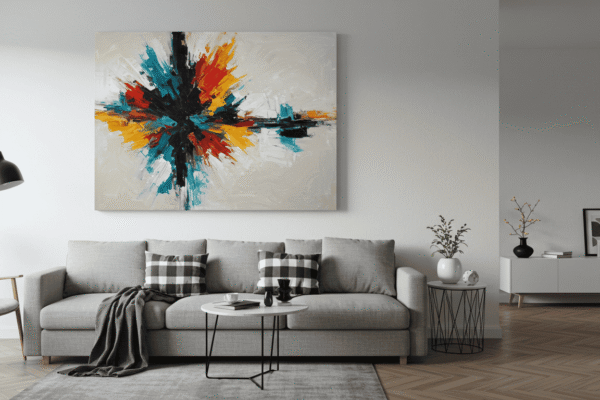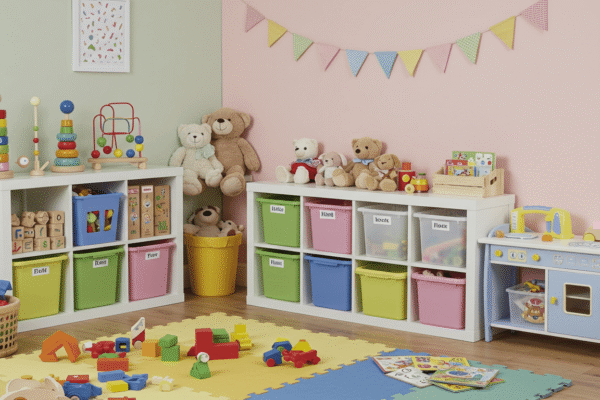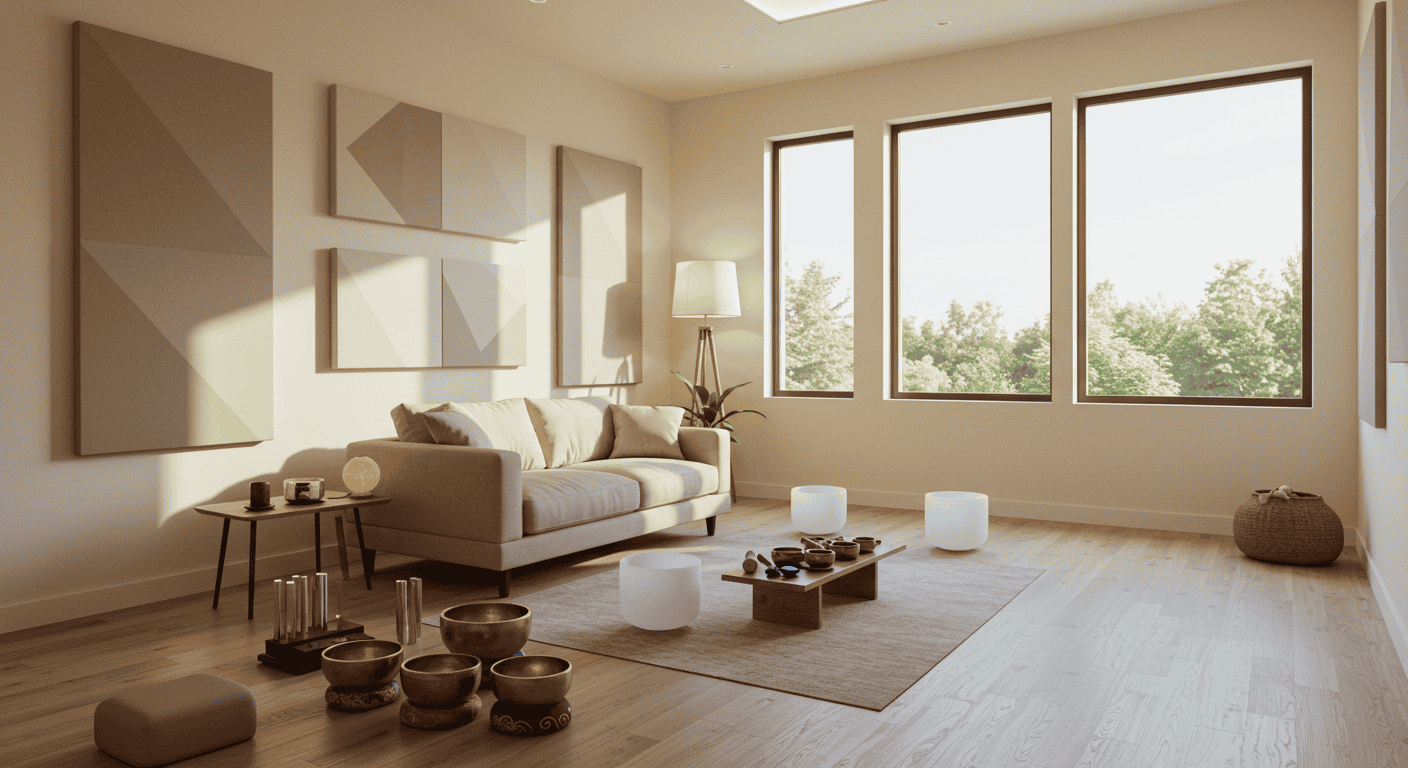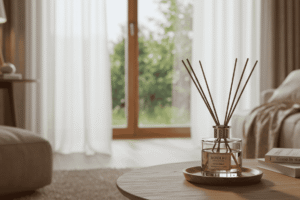There is a growing shift toward practical, sensory-first wellness methods that calm the nervous system, improve sleep, and create a restorative home atmosphere, and few approaches feel as accessible and immediate as sound therapy. By working with vibrations, frequencies, and steady textures, a routine can be crafted that reduces mental load, encourages mindful breathing, and reshapes daily transitions from busy to balanced in a way that is both gentle and sustainable. An everyday practice can be as simple as a ten-minute session before bedtime, a short noon reset to clear mental fog, or an immersive sound bath on slower weekends to deepen relaxation and reflection with this therapy.
Sound Therapy: What It Is
At its core, sound therapy refers to the intentional use of sound to shift mind-body states toward relaxation, clarity, and equilibrium, guided by principles like resonance, entrainment, and sensory regulation. While it is related to music listening, this practice is not limited to songs or melodies; rather, it emphasizes tone, rhythm, and texture to influence arousal, attention, and breath patterns in a predictable way. People use sound baths, simple drones, nature ambiences, and colored noise to create more consistent calm, to ease anxiety spikes, and to support restorative routines with this therapy.
The Science in Brief
Although science is still refining the exact mechanisms, a practical picture is emerging in which sound therapy nudges brainwaves from alert states toward alpha and theta ranges associated with relaxation and meditative focus. This is accompanied by shifts in autonomic balance, where heart rate variability may improve and stress markers trend in calmer directions when listening is paced sensibly and paired with steady breathing. The interplay between predictable auditory input and body awareness appears to create a feedback loop that steadily promotes downregulation with this therapy.
Modalities You’ll Meet
The main routes of sound therapy include live or recorded sound baths, gently layered drones, nature ambiences like rain or ocean, binaural beats delivered via headphones, and tactile or resonant instruments such as singing bowls, gongs, and tuning forks. Many people also use colored noise—white, pink, or brown—to mask distracting sounds and support sleep onset or focus periods. Choosing a modality is less about theory and more about how the texture feels in the body and how easily the practice fits into the daily rhythm with this therapy.
Quick Reference Table
To help with fast decisions, the following table summarizes common modalities used in sound therapy along with typical settings and goals so planning a personal routine becomes straightforward.
| Modality | Typical Duration | Setting | Primary Goal | Notes |
|---|---|---|---|---|
| Sound bath (live/recorded) | 20–40 min | Quiet room, reclined | Deep relaxation | Best for end-of-day wind-down in sound therapy |
| Binaural beats | 10–30 min | Headphones, seated | Calm/focus | Use low volume; avoid during tasks needing full situational awareness in sound therapy |
| Nature ambience | 10–60 min | Speakers, low light | Stress relief | Gentle textures suit anxious periods in sound therapy |
| Colored noise (white/pink/brown) | 15–45 min | Speakers or headphones | Sleep/focus | Pink/brown often feel smoother for sleep in sound therapy |
| Singing bowls/gongs | 10–25 min | Sitting or lying | Grounding | Prefer lower volumes, longer exhales in sound therapy |
| Tuning forks | 5–15 min | Sitting, calm space | Tension release | Short targeted sessions in sound therapy |
How Sound Therapy Works
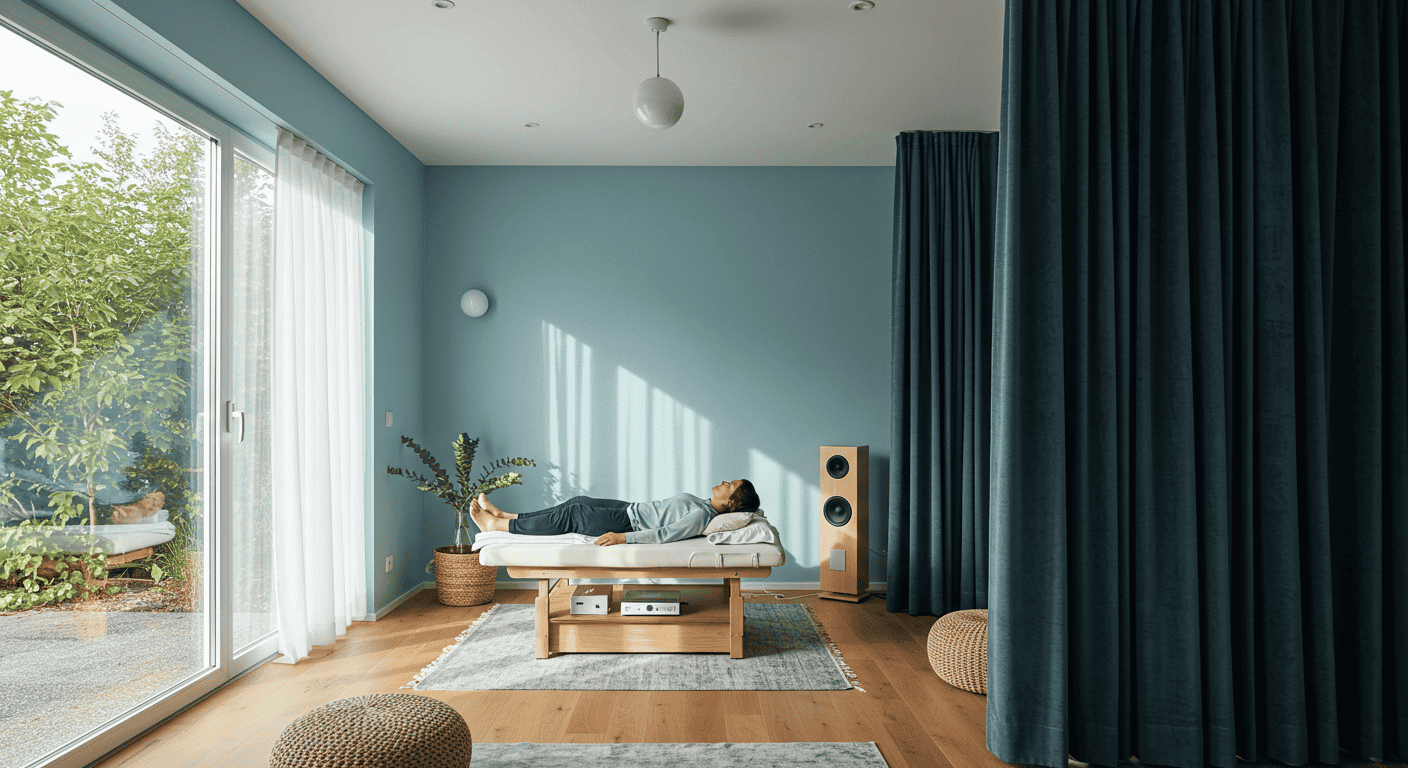
The body’s response to sound therapy is a combination of auditory processing, resonance through tissues, and cognitive-emotional shifts that together create a calmer internal environment. Regular sessions encourage patterned attention toward steady sound, which gently reduces mental chatter while allowing breath and heart rhythms to settle. Over time, the nervous system learns that these cues signal safety and rest, making it easier to downshift on demand with this therapy.
Brainwaves and States
One useful framework for sound therapy is the brainwave model, not as a rigid rulebook but as a way to describe subjective state changes from busy beta toward restful alpha and occasionally meditative theta. People often report easier breathing, warmer limbs, and softer focus as listening proceeds and the mind becomes more present-centered. This shift is usually subtle and cumulative, strengthened by consistent routines that anchor the day with this therapy.
Body Signals to Watch
Because sound therapy is experiential, tracking small body cues becomes important for personalization, including breath pace, jaw and shoulder tension, and the sense of visual softness behind closed eyes. Positive trends often involve a calmer chest, slower exhales, and a gentle increase in perceived spaciousness that lingers for several minutes after the session. These qualitative markers, alongside simple notes on mood or sleep onset, offer reliable guideposts for tailoring the approach with this therapy.
Mechanisms Table
The table below maps input types to common physiological and perceived effects to make the practice easier to adapt within sound therapy.
| Input Type | Likely Physiological Shift | Common Perception | Practical Cue |
|---|---|---|---|
| Steady low-frequency drone | Reduced arousal | Grounded, heavy limbs | Lengthen exhales in sound therapy |
| Soft nature ambience | Smoother breathing | Spacious, calm | Dim lights or eye mask in sound therapy |
| Binaural beats (relax focus) | Attentional settling | Tunnel of focus | Keep volume low in sound therapy |
| Colored noise (pink/brown) | Noise masking | Quiet mind | Use before sleep in sound therapy |
| Singing bowls/gongs | Tonic relaxation | Warm, enveloped | Finish with silence in sound therapy |
Benefits Backed by Research
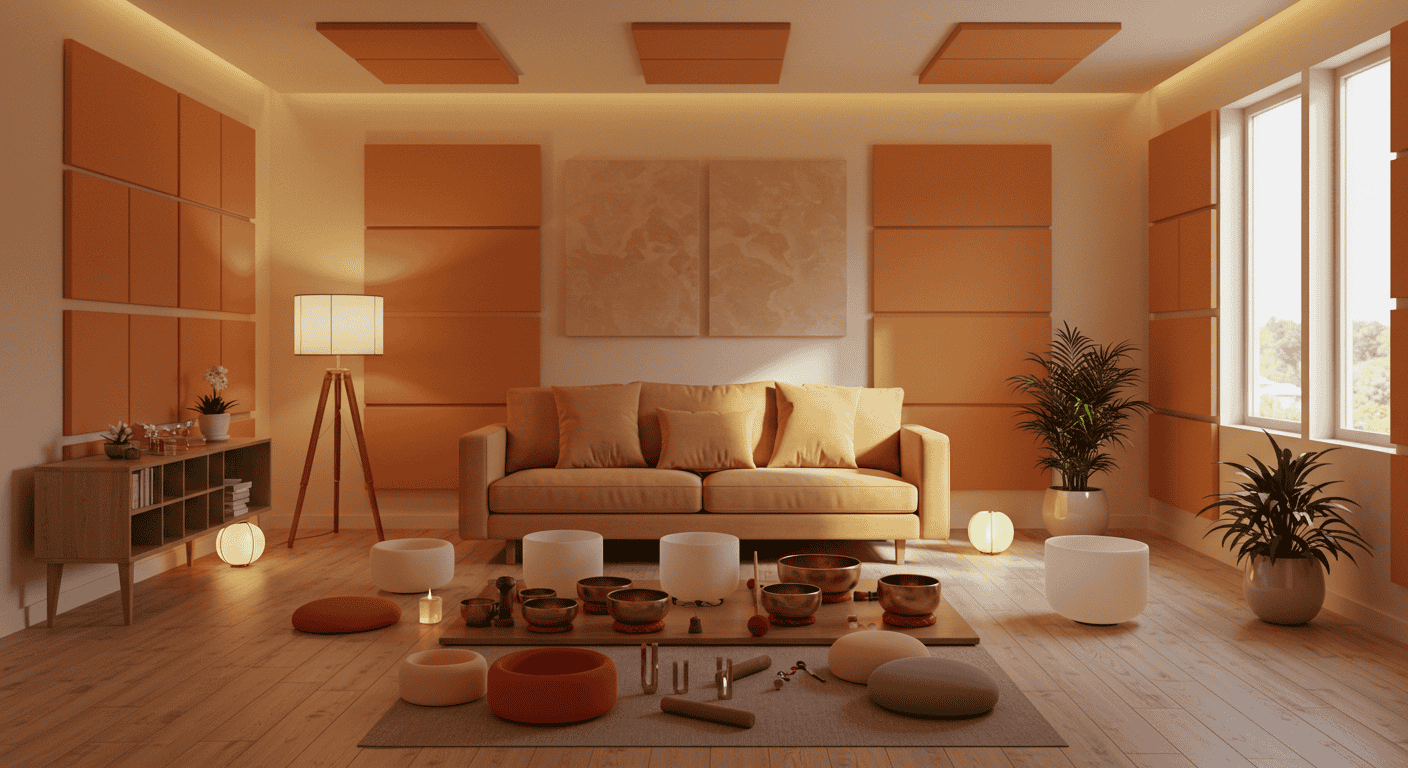
While individual results vary, a consistent theme across practice is that sound therapy supports stress relief, gentle mood enhancement, and sleep readiness by delivering reliable sensory cues for relaxation. People learning to notice breath length and mental spaciousness often find the transition from daytime tension to evening ease becomes more predictable. Over weeks, the accumulated effect is not only deeper rest but smoother recovery from daily overstimulation through this therapy.
Stress, Mood, and Focus
Stress responses are sensitive to predictability and rhythm, which is why sound therapy tends to be effective when textures are steady and volumes remain comfortable. This steadiness helps reduce emotional reactivity and promotes a more measured awareness that blends clarity with calm. For focus blocks, non-lyrical, low-distracting sound can be paired with short breaks to keep cognition sharp without tipping into tension using this therapy.
Sleep and Wind-Down
Pre-sleep routines are an ideal context for sound therapy because slow textures pair naturally with darker rooms and quiet breathing to cue melatonin-friendly states. A 15–20 minute wind-down is often sufficient, especially when followed by two minutes of silence to let the body register the difference. People who struggle with racing thoughts find this combination softens mental momentum before bed with this therapy.
Evidence Snapshot Table
Although not all outcomes will apply to every person, this table captures common trends and considerations to set realistic expectations for sound therapy.
| Outcome | Measure/Marker | Typical Direction | Notes |
|---|---|---|---|
| Stress reduction | Perceived calm | Improves over weeks | Consistency matters in sound therapy |
| Mood support | Self-report scales | Mild to moderate gains | Pair with breath cues in sound therapy |
| Sleep onset | Sleep latency | Shortens modestly | Use low light in sound therapy |
| Focus stability | Task persistence | Improves with practice | Non-lyrical textures in sound therapy |
Practical Home Setup
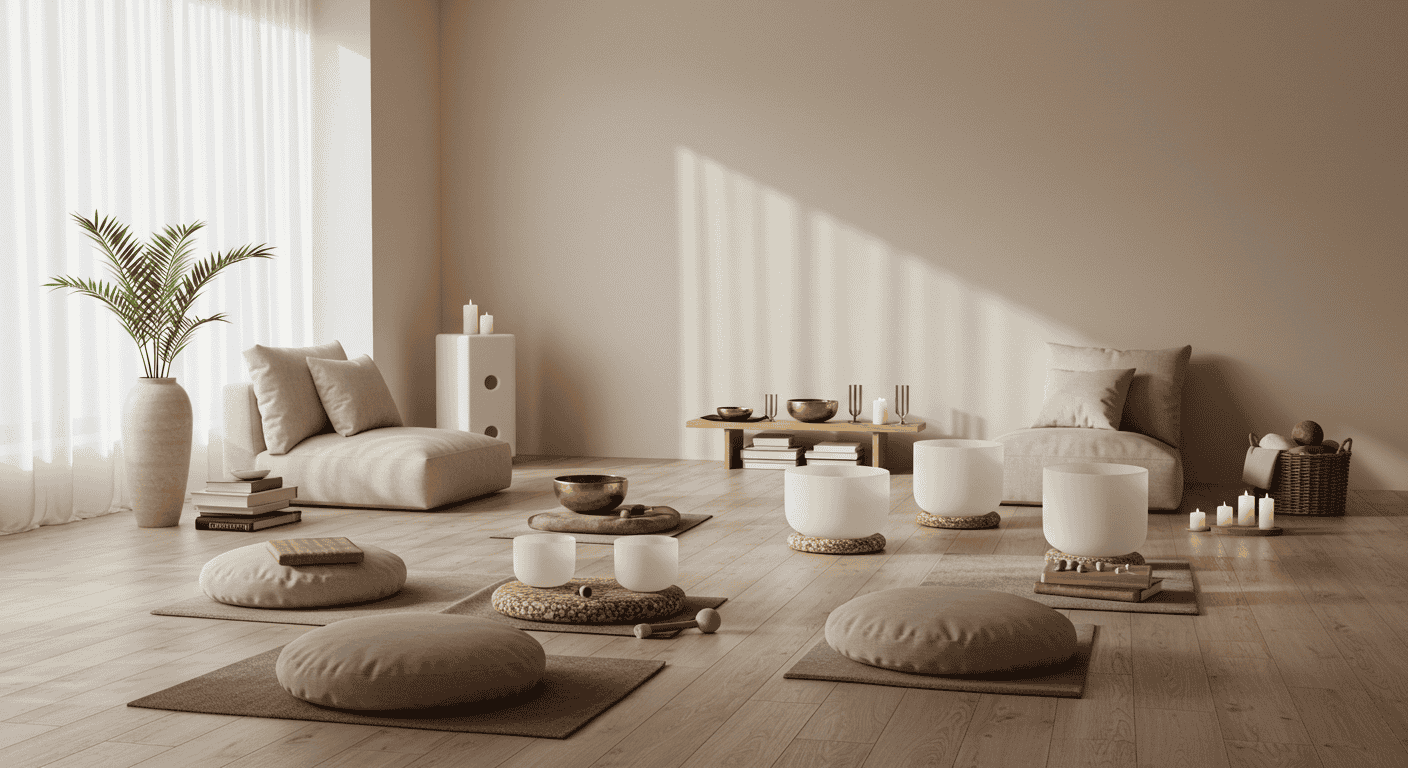
Transforming a corner of the home into a sanctuary for sound therapy can be simple and enjoyable, emphasizing comfort, quiet, and repeatable conditions. Soft furnishings, a supportive chair or mat, and intentional lighting create a refuge that signals the nervous system to soften. Over time, merely entering this environment becomes a cue for exhale and ease, reinforcing the practice loops that make this therapy effective.
Choose Your Modality
When starting sound therapy, begin with one or two textures that feel trustworthy and uncomplicated, like ocean ambience, pink noise, or an uncluttered drone, before branching into more resonant instruments. Headphones can offer privacy and consistency, while speakers feel more open and shared; both are valid depending on the situation. The goal is to reduce friction so the session begins on time and ends with a satisfying sense of completion in this therapy.
Acoustic Tips
Small acoustic improvements greatly enhance sound therapy, such as placing rugs, cushions, or curtains to soften reflections and positioning speakers away from corners to avoid harsh buildup. If noise bleed is an issue, consider sound zoning by placing the setup in a quieter room or using low-volume listening paired with deeper breathing. The aim is a smooth, comforting field of sound that invites the body to settle with this therapy.
Setup Checklist Table
Use this checklist to design a consistent, calming environment for sound therapy sessions.
| Element | Recommendation | Why It Helps | Notes |
|---|---|---|---|
| Room | Quiet, soft surfaces | Reduces harsh reflections | Rugs/cushions in therapy |
| Time | Fixed daily slot | Builds habit strength | Evening calm in therapy |
| Lighting | Dim, warm tone | Signals wind-down | Avoid glare in therapy |
| Volume | Comfortably low | Prevents fatigue | Hear breath in therapy |
| Duration | 10–20 minutes | Easy to sustain | Add silence in therapy |
Guided Protocols by Goal
Structured routines make sound therapy easier to maintain and evaluate, turning good intentions into repeatable experiences that reliably shift state. The following protocols are designed for simplicity, requiring only a chosen sound source, a comfortable posture, and gentle breath awareness paced by a timer. Each session concludes with a brief silence to integrate the experience within this therapy.
Calm and Stress Relief
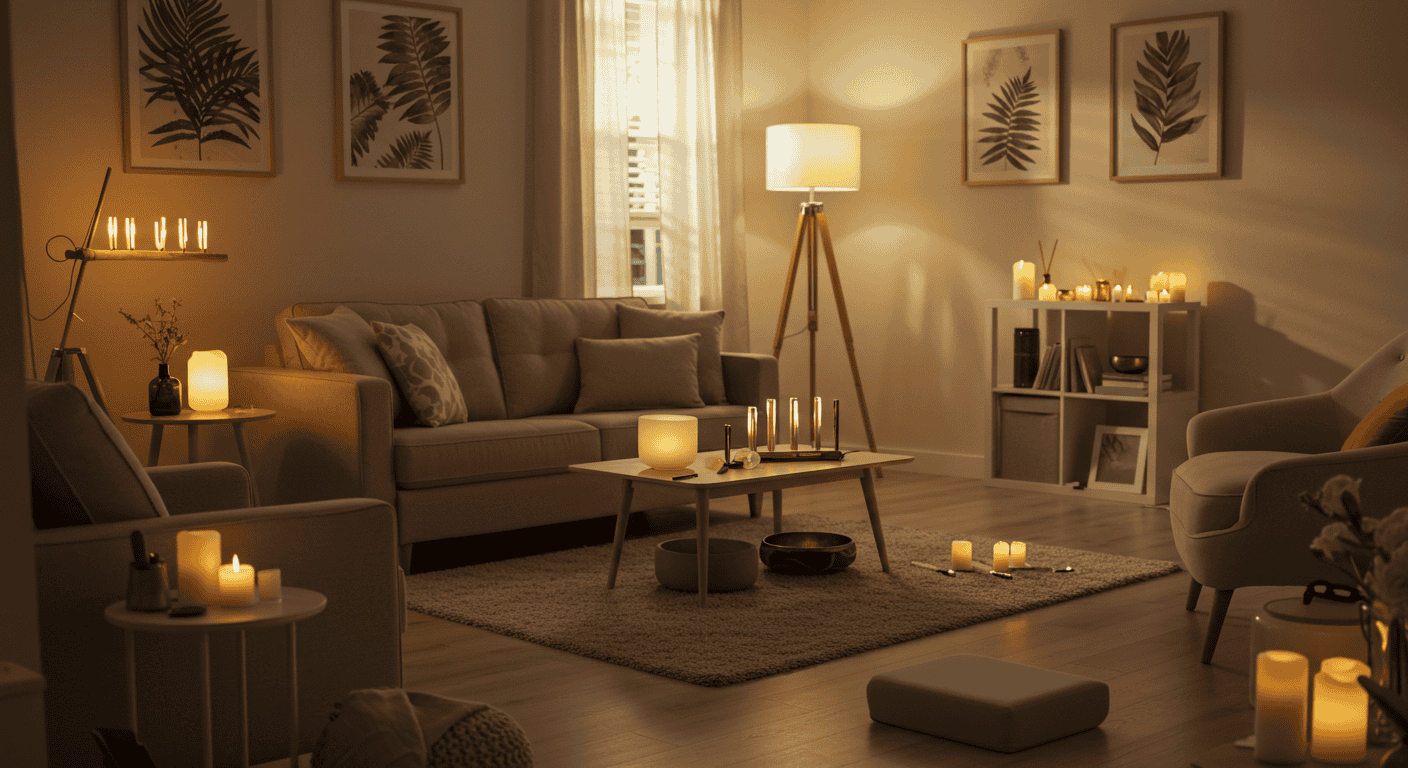
For steady calm, select a soothing texture and set a timer for twelve to fifteen minutes in sound therapy. Sit or lie comfortably, soften the jaw and shoulders, and breathe through the nose with a focus on lengthening the exhale by one or two counts beyond the inhale; allow thoughts to pass without chasing them. When the timer finishes, sit in quiet for two minutes, noticing warmth or heaviness as signs of successful downshifting in this therapy.
Sleep Readiness
About twenty minutes before bed, choose a low-frequency, low-volume texture with minimal variation to encourage a drift toward sleep with sound therapy. Keep lights dim, limit screens, and guide attention to the breath, favoring slower exhales and brief pauses at the bottom to signal readiness for rest. End with silence and avoid evaluating the session so the mind does not re-activate in this therapy.
Focus Block
For work periods, play a non-lyrical, steady sound at a barely-there volume for twenty-five to forty minutes, then take a three-minute break in sound therapy. If attention wavers, adjust volume slightly or sit up taller rather than switching tracks, which can reintroduce novelty-seeking. After the break, resume with the same sound to keep cognitive context stable in this therapy.
Protocol Builder Table
Use this table to fine-tune sessions to the situation and goals of sound therapy.
| Goal | Length | Sound Profile | Breath Cue | Tracking Metric |
|---|---|---|---|---|
| Calm | 12–15 min | Soft, steady | Longer exhales | Perceived calm in therapy |
| Sleep | 15–20 min | Low, minimal change | Slow nasal | Sleep latency in therapy |
| Focus | 25–40 min | Non-lyrical steady | Even pacing | Task completion in therapy |
Frequencies, Noise Colors, Brainwaves
Curiosity about specific frequencies is natural, but practical sound therapy works best when anchored in subjective comfort rather than rigid formulas. Different textures have different feels: pink and brown noise often sound smoother than white noise, and low, warm drones may feel grounded compared to bright, shimmering tones. Use personal response as the final guide, noting which choices consistently deliver desired states with this therapy.
Brainwave Mapping
In informal terms, sound therapy that gently simplifies the auditory field tends to promote an alpha-dominant calm, occasionally dipping into theta during deeper relaxation. What truly matters is repeatable experience rather than chasing precise numeric targets, since stress relief arises from the whole context—sound, breath, posture, light—acting together. Keep the emphasis on how the body responds over time within this therapy.
Frequency Myths vs Use
The most reliable approach to sound therapy is to choose a texture that feels immediately soothing and stick with it long enough for the nervous system to recognize it as a cue. Swapping tracks frequently or chasing special numbers often introduces novelty that delays settling and dampens the calming effect. Allowing the same sound to become a ritual shorthand speeds state changes in sound therapy.
Reference Table
This table summarizes common textures and their typical uses so experiments can be intentional and enjoyable in sound therapy.
| Texture/Noise | Subjective Feel | Best Use | Caveat |
|---|---|---|---|
| Pink noise | Smooth, soft | Pre-sleep | Keep volume low in therapy |
| Brown noise | Warm, deep | Grounding | May feel heavy in therapy |
| White noise | Bright, steady | Masking | Can be harsh in therapy |
| Low drone | Stable, enveloping | Calm | Avoid boominess in therapy |
| Nature ambience | Organic, soothing | Stress relief | Avoid abrupt loops in therapy |
Safety, Sensitivities, and Limits
Sustainable sound therapy respects hearing comfort, sensory thresholds, and gradual exposure, ensuring sessions remain inviting rather than overwhelming. Favor low to moderate volumes that allow easy nasal breathing and an unforced jaw, pausing immediately if dizziness or headaches appear. People with sensory sensitivities or neurological considerations should start with shorter durations and gentler textures in this therapy.
Hearing Health Basics
Comfortable loudness is the rule in sound therapy, which helps prevent fatigue and allows attention to rest on breath and felt sensation. Short breaks between sessions keep the ears and nervous system fresh, especially when headphones are used. When unsure, lower volume is almost always the wiser choice in this therapy.
When to Seek Guidance
If sound therapy repeatedly triggers migraine-like symptoms, intensified tinnitus, or unusual disorientation, consult a healthcare professional to rule out underlying issues and adjust the approach. Safety includes tailoring textures to personal thresholds and avoiding high-intensity sounds that can agitate rather than soothe. Clarity and comfort are the compass for all adjustments in sound therapy.
Risk/Response Table
This quick table supports sensible choices during sound therapy by mapping common reactions to practical adjustments.
| Symptom | Likely Trigger | Immediate Adjustment | When to Pause |
|---|---|---|---|
| Headache | Volume too high | Lower volume | If persists in sound therapy |
| Dizziness | Low-frequency intensity | Change texture | If recurring in sound therapy |
| Irritability | Harsh brightness | Use pink/brown | If frequent in sound therapy |
| Restlessness | Too much variation | Choose steady sound | If daily in sound therapy |
Personalization and Tracking
The secret to long-term success with sound therapy is a light-touch approach to data: just enough tracking to notice trends without turning a calming ritual into a measurement project. A weekly log noting session type, duration, perceived calm, and sleep latency is usually sufficient to guide steady improvements. Preference often predicts outcome, so if a texture consistently feels good, keep it as a signature cue in this therapy.
Habit Design
Anchoring sound therapy to an existing routine—after work, before bed, or following a walk—ensures sessions begin on time and become automatic. Start with short, pleasant practices so the mind associates the ritual with relief, extending length only when it feels natural. Reliability, not intensity, is what reshapes nervous system patterns in this therapy.
Progress Table
Use this table to reflect on small week-over-week improvements and refine therapy choices with confidence and ease.
| Date | Goal | Session Details | Perceived Calm (1–5) | Sleep/Focus Notes | Adjustment |
|---|---|---|---|---|---|
| Week 1 | Sleep | Pink noise, 15 min | 3 | Faster sleep | Lower volume in therapy |
| Week 2 | Calm | Low drone, 12 min | 4 | Less tension | Add 2 min silence in therapy |
| Week 3 | Focus | Steady non-lyrical, 30 min | 4 | Fewer distractions | Keep same track in therapy |
| Week 4 | Sleep | Nature ambience, 20 min | 5 | Deeper rest | Maintain routine in therapy |
FAQs and Quick Comparisons
People often want clear answers about session length, equipment needs, and the differences between intentional listening and passive background audio, which is where therapy offers simple, evidence-informed guidelines. A practical approach is to start with ten to twenty minutes and a texture that reliably feels good, then adjust volume and duration based on how calm and clear the body feels afterward. With consistent practice, this becomes a trustworthy self-regulation tool woven into daily life through therapy.
Fast Answers
For relaxation, most begin with twelve to fifteen minutes, adding two quiet minutes at the end to let the body consolidate the shift in therapy. Headphones can be helpful for privacy or binaural beats, while speakers tend to feel more open and less fatiguing for sleep routines. If uncertain, choose the simplest texture and the most comfortable volume to build confidence with this therapy.
Comparison Table
This table clarifies when intentional sound practices offer advantages over passive listening or silence so that sound therapy choices fit the moment.
| Approach | Best Use Case | Pros | Cons |
|---|---|---|---|
| Sound therapy | Calm, sleep, focus | Structured, repeatable | Needs intention in therapy |
| Background music | Light mood lift | Familiar, easy | Can distract in therapy |
| Silence | Integration, reflection | Deep awareness | May feel stark in therapy |
For related home wellness routines, explore practical habit design and calming environment tips on this internal resource: ameliastips.com, where this therapy can be combined with lighting and breath practices for greater effect. For a trustworthy external primer on auditory health and safe listening that complements gentle practices, consult this public resource: National Institute on Deafness and Other Communication Disorders, and adapt volume and duration to personal comfort within therapy.
Conclusion: Building a Calming Practice with Sound Therapy
Done thoughtfully and consistently, sound therapy becomes a friendly ritual that invites the body to settle and the mind to refocus, turning ordinary corners of the home into reliable sanctuaries. The most powerful changes rarely come from exotic frequencies or elaborate setups but from steady textures, comfortable volumes, and small daily wins that accumulate into profound ease over time. When paired with gentle breathwork, simple tracking, and a patient attitude, this practice scales beautifully from busy weekdays to unhurried weekends, keeping balance close at hand through this therapy.



